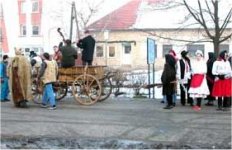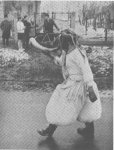Customs in Hungary
![]()
Here are some
of the main holiday customs practiced here in Hungary !
|
Names
Days
In Hungary,
Easter is a 2 day holiday. On Easter Monday, traditionally there was a
custom of "sprinkling." This custom goes back a very long time. Where it
is practiced, on Easter Monday boys and men visit all the women they know.
Boys in groups, single men, or fathers with sons will leave early in the
morning and are out all day long. They greet girls or women at their gates
with some kind of poem (usually humorous) and then sprinkle the
girls/women with perfume. The girls/women are then expected to provide
them with food and drink (palinka/schnapps if they are adults) and a
decorated Easter egg. (women would be preparing those the day or two
ahead)and these days, boys prefer money. In earlier times, women had water
poured on them, being dragged to the well and water dumped on them from a
pail. Probably this custom had pagan origins and fertility rituals. Where
it is still practised, by the end of the day the men are drunk and the
women badly need a bath to get rid of all the cheap perfume! (This custom
is starting to die out and Jer is glad of that, as she finds it very
annoying not to be able to go out or answer the door on that day!) Traditionally there have often been small fairs, with rides and food and entertainment at Easter as well.
|
The origins of May Day are pagan in origin, but for many years in all of Europe (indeed throughout much of the world) it is celebrated as "Labour Day" and there are fairs and sometimes parades. The parade for May Day was a very big thing in the Soviet times and folks were often pretty much forced to march in them, and the traditional celebrations were not encouraged.
Here are 3 Russian
folksongs often heard at that same time , *Katjusha* (12Kb) ...our alarm clock plays this tune! Since the collapse of the Soviet Union,
fairs for having fun are popular. At these fairs you can often still see such things as puppet
shows and players performing shows on stilts that would have looked and
sounded pretty much the same in the middle ages! This is something that Jer is always fascinated to see...these "windows on the past".
We took the pictures below at one of these May Day fairs.
All Saints Day November 1 is
All Saints Day, which is a very old European tradition (It is no
longer practiced in many countries, or perhaps only in rural areas.)
Families go to the cemeteries where their loved ones are buried and bring
flowers, wreaths and/or candles to lay upon the graves. The older type
grave markers were posts carved out of wood but the newer ones are
somewhat like New Orleans style stone boxes above ground. This might sound
strange or creepy, but it really is a moving experience to be there with all the
twinkling lights and the people who have to pay respects to family
members.
Farsang In February is a holiday Hungarians call "farsang" (pronounced "far-shung". This is a very old holiday, dating from pagan times, which is still practiced in a number of central European countries. Folks wore scary masks and carried instruments which made very loud noises such as bells and drums and marched through the streets to "scare the evil spirits away", and the children got candy. This kind of thing now takes place mostly in villages. In cities, what they usually do is a "masquerade party" for the kids at someone's house or at school, where they go with their parents and have something that resembles a Halloween party in the USA. (This holiday is called 'Fastnacht" or "Fasching" in Austria and Germany, and is now more like Carnival in being celebrated as a chance to party and have fun before Lent.) |
 |
 |
 |
"farsang" being celebrated in villages